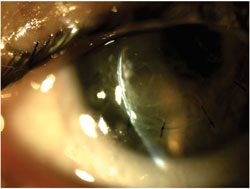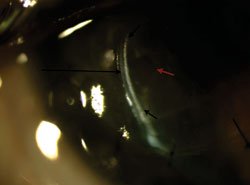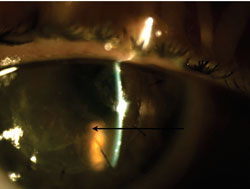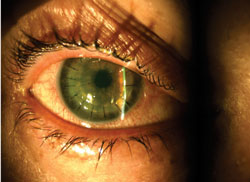Technique manages post-LASIK corneal perforation
Amniotic membrane transplant with fibrin glue safely relocates the hole in the LASIK flap to the superior stromal bed.
Corneal perforation is an ocular emergency requiring immediate surgical intervention for the best possible outcome.
 Thomas John |
However, during the acute stage, the eye is usually inflamed, and intraocular intervention may be more suitable when the eye is quiet and not inflamed. Hence, a two-stage surgical approach is usually a better choice if possible. In the first stage, the surgical goal is to seal the perforation and attain structural, tectonic integrity of the globe with limited or no intraocular intervention. Later, when the eye is quiet, an intraocular surgical procedure may be performed to best visually rehabilitate the patient and obtain the best possible visual result.
In this column, Drs. Fass and Herman describe a novel surgical technique of amniotic membrane transplant with fibrin glue and a lamellar autograft rotation of a LASIK flap post-LASIK ectasia, descemetocele and corneal perforation with a positive Seidel test. This initial procedure was then to be followed by a full-thickness penetrating keratoplasty at a later date when the eye is quiet.
– Thomas John, MD
OSN Surgical Maneuvers
Editor
 Oren N. Fass |
The existence of LASIK-induced ectasia is well-recognized, but the occurrence of post-LASIK corneal hydrops and perforation is an even rarer complication.
We describe one such case and the surgical techniques used to manage the corneal perforation.
 Figure 1. Intraoperative photo (surgeon’s view) after LASIK flap has been rotated 180°. Long black arrow indicates the large hole in the LASIK flap that now rests on a normal stromal bed. Short black arrows show the edges of the amniotic membrane that is now covered by what was the superior LASIK flap. The hole through the stromal bed is demarcated by the small red arrow. Images: Fass O |
Case description
A 50-year-old woman presented to our cornea clinic 11 years after a highly myopic LASIK ablation with a history of corneal ectasia, photophobia and blurred vision in the right eye. Ocular examination revealed a visual acuity of hand motion. Biomicroscopic evaluation revealed a descemetocele with corneal perforation in the inferolateral quadrant, a flat anterior chamber and a positive Seidel test.
Surgical technique
Intraoperative evaluation of the involved right cornea showed that the perforation was larger than originally estimated by clinical examination. It was determined that the size of the corneal perforation was larger than optimal for surgical repair using amniotic membrane without additional surgical measures.
The anterior chamber was reformed using viscoelastic, and the LASIK flap was lifted. An attempt was made to place an amniotic membrane over the region of the perforation. The amniotic membrane was used in a two-layered approach and was attached with fibrin glue, and the LASIK flap was allowed to cover the amniotic membrane. However, this attempt failed to fully seal the perforation, and aqueous leakage was found at the edges of the amniotic membrane. The membrane that was located directly over the corneal defect began to assume a descemetocele-like deformation due to poor structural integrity.
The LASIK flap was excised with a pair of Vannas scissors. The flap was then rotated 180· and attached to the corneal bed and amniotic membrane with fibrin glue (Figure 1). Eight interrupted 10-0 nylon sutures were placed radially around the LASIK flap. At the completion of this surgical repair, repeat Seidel test was negative. Through an inferior paracentesis, irrigation and washout was performed with sterile balanced salt solution.
Postoperative result
Figure 2 shows the postoperative day 1 appearance of the right eye with a formed anterior chamber, and the Seidel test was negative. There was no bulging descemetocele-like deformation of the amniotic membrane due to the structural covering of the intact superior half of the LASIK flap (Figure 3). The hole in the LASIK flap is safely relocated to the superior stromal bed (Figure 4). At 1-week follow-up, the visual acuity was 20/150. The eye exhibited a formed and quiet anterior chamber with a well-sealed wound (Figure 5). The patient was scheduled for a PK within 1 to 2 weeks.
 Figure 2. Slit-lamp photograph on day 1 after the surgical repair, showing a formed anterior chamber and Seidel negative wound. |
 Figure 3. The site of stromal bed perforation is indicated by the short red arrow. A pocket of fluid is present under the amniotic membrane. Short black arrows demarcate the area of fibrin glue sealant. A long black arrow highlights the intact LASIK flap covering the perforation site. |
 Figure 4. Long black arrow identifies LASIK flap defect now located over the intact superior corneal stroma. |
 Figure 5. At 1-week follow-up, the visual acuity was 20/150. The eye exhibited a formed and quiet anterior chamber with a well-sealed wound. |
References:
- Aldave AJ, Mabon M, Hollander DA, McLeod SD, Spencer WH, Abbott RL. Spontaneous corneal hydrops and perforation in keratoconus and pellucid marginal degeneration. Cornea. 2003;22(2):169-74.
- Chen CL, Tai MC, Chen JT, Chen CH, Chang CJ, Lu DW. Acute corneal hydrops with perforation after LASIK-associated keratectasia. Clin Experiment Ophthalmol. 2007;35(1):62-65.
- Duchesne B, Tahi H, Galand A. Use of human fibrin glue and amniotic membrane transplant in corneal perforation. Cornea. 2001;20(2):230-2.
- Kim HK, Park HS. Fibrin glue-assisted augmented amniotic membrane transplantation for the treatment of large noninfectious corneal perforations. Cornea. 2009;28(2):170-6.
- Maier P, Böhringer D, Reinhard T. Clear graft survival and immune reactions following emergency keratoplasty. Graefes Arch Clin Exp Ophthalmol. 2007;245(3):351-359.
- Oren N. Fass, MD, can be reached at Vision Quest Surgery Center, 5421 La Sierra Drive, Dallas, TX 75231; e-mail: orenfass@hotmail.com. Dr. Fass has no financial interest in any aspect of this article.
- Thomas John, MD, is a clinical associate professor at Loyola University at Chicago and is in private practice in Tinley Park and Oak Lawn, Ill. He can be reached at 708-429-2223; fax: 708-429-2226; e-mail: tjcornea@gmail.com. Dr. John has no financial interest in any aspect of this article.

